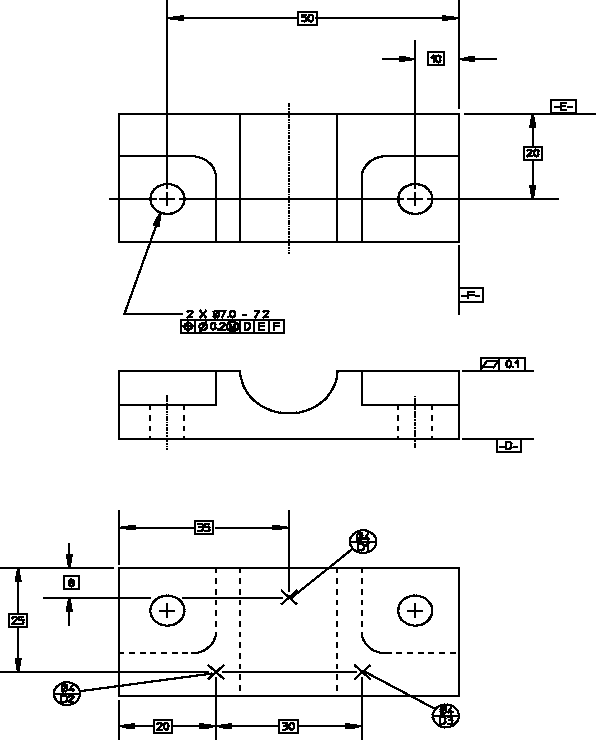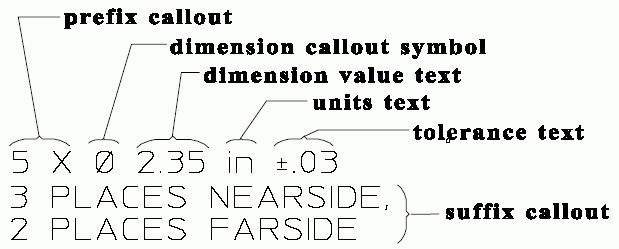|
|
Application module:
Draughting element specialisations |
ISO/TS 10303-1312:2018-11(E)
© ISO
|
This clause specifies the information requirements for the
Draughting element specialisations
application module. The information requirements are specified as the
Application Reference Model (ARM) of this application module.
NOTE 1 A graphical representation of the information
requirements is given in
Annex C.
NOTE 2 The mapping specification is specified in
5.1. It shows how
the information requirements are met by using common resources and
constructs defined or imported in the MIM schema of this application
module.
This clause defines the information requirements to which implementations shall
conform using the EXPRESS language as defined in ISO 10303-11.
The following begins the
Draughting_element_specialisations_arm
schema and identifies the necessary external references.
EXPRESS specification:
*)
SCHEMA Draughting_element_specialisations_arm;
(*
The following EXPRESS interface statement specifies the elements
imported from the ARM of another application module.
EXPRESS specification:
*)
USE FROM
Draughting_element_arm;
--
ISO/TS 10303-1310
(*
NOTE 1
The schemas referenced above are specified in the following
part of ISO 10303:
| Draughting_element_arm |
ISO/TS 10303-1310 |
NOTE 2
See Annex C,
Figures
C.1and C.2
for a graphical representation of this schema.
This subclause specifies the ARM types
for this application module. The ARM types and
definitions are specified below.
A chained_or_parallel lists the types of an alignment.
EXPRESS specification:
*)
TYPE
chained_or_parallel =
ENUMERATION
OF
(chained,
parallel);
END_TYPE;
(*
Enumerated item definitions:
chained:
the alignment is chained;
parallel:
the alignment is parallel.
The dimension_callout_select type is an
extensible list of alternate data types
that allows for the designation of the data
type
Annotation_text_occurrence.
NOTE
The list of entity data types may be
extended in application modules that use the constructs of
this module.
EXPRESS specification:
*)
TYPE
dimension_callout_select =
EXTENSIBLE
GENERIC_ENTITY
SELECT
(Annotation_text_occurrence);
END_TYPE;
(*
A dimension_type lists the types of a dimension.
EXPRESS specification:
*)
TYPE
dimension_type =
ENUMERATION
OF
(angular,
curve,
diameter,
leader_directed,
linear,
ordinate,
radius);
END_TYPE;
(*
Enumerated item definitions:
angular:
the dimension type is angular;
curve:
the dimension type is curve;
diameter:
the dimension type is diameter;
leader_directed:
the dimension type is leader directed;
linear:
the dimension type is linear;
ordinate:
the dimension type is ordinate;
radius:
the dimension type is radius.
A primary_or_secondary lists the types of a relation.
EXPRESS specification:
*)
TYPE
primary_or_secondary =
ENUMERATION
OF
(primary,
secondary);
END_TYPE;
(*
Enumerated item definitions:
primary:
the relation is primary.
secondary:
the relation is secondary.
This subclause specifies the ARM entities for this
module. Each ARM application entity is an atomic element that
embodies a unique application concept and contains attributes
specifying the data elements of the entity. The ARM
entities and definitions are specified below.
A Datum_feature_callout is a type of
Draughting_element.
A Datum_feature_callout is a callout that is used to denote a point, line,
or plane as a datum and that specifies the designation to be used as identification of that datum.
EXAMPLE
The top view in
figure 1
shows some Datum_feature_callout objects for datums labeled 'E' and 'F'.
Figure 1 — Draughting callouts on a drawing
EXPRESS specification:
*)
ENTITY Datum_feature_callout
SUBTYPE OF (Draughting_element);
END_ENTITY;
(*
A Datum_target_callout is a type of
Draughting_element.
A Datum_target_callout is a type of callout that is used to denote points, lines, and surfaces of contact,
on a part, which are used in establishing a reference datum.
The callout contains an alphanumeric designation and, where applicable, a specification of the diametrical size of the target
area.
EXAMPLE
The bottom view in
figure 1
shows three datum target points and their associated datum target symbols.
EXPRESS specification:
*)
ENTITY Datum_target_callout
SUBTYPE OF (Draughting_element);
END_ENTITY;
(*
A Dimension is a type of
Draughting_element
that is the graphical presentation of the dimension value, of associated information,
and of the symbology necessary to accurately depict its area of application.
A Dimension is either a
Dimension_callout
or additionally is a
Dimension_value.
Dimension objects cover linear dimensions, angular dimensions, curve dimensions,
diameter dimensions, ordinate dimensions, radius dimensions, and leader directed dimensions.
For this particular type of
Draughting_callout,
the inherited attribute 'contents' shall refer to
Annotation_curve
and
Annotation_text_occurrence
objects only.
EXAMPLE
Examples for the symbology are leaders, projection curves, or dimension curves.
EXPRESS specification:
*)
ENTITY Dimension
ABSTRACT SUPERTYPE
OF (Dimension_callout
ANDOR Dimension_value)
SUBTYPE OF (Draughting_element);
id : STRING;
END_ENTITY;
(*
Attribute definitions:
id:
the identifier of the Dimension.
A Dimension_callout is a type of
Dimension.
A Dimension_callout is a combination of text and of symbology that conveys presentation information about a dimension.
This includes the dimension value, dimension units, tolerance information and any related notes.
EXPRESS specification:
*)
ENTITY Dimension_callout
SUBTYPE OF (Dimension);
callout_element : SET[1:?] OF dimension_callout_select;
dimension_type : SET[1:?] OF dimension_type;
END_ENTITY;
(*
Attribute definitions:
callout_element:
the text and possibly symbol that form the Dimension_callout.
dimension_type:
specifies a set of
dimension_type
for the Dimension_callout.
A Dimension_callout_relationship is a relationship of a
Dimension_value
to a
Dimension_callout
as either primary or secondary value.
This entity is required when a primary and a secondary dimension value for different units has to be presented.
In the case that only a single unit and value is to be presented instances of both types
Dimension_callout
and
Dimension_value
shall be created instead of using Dimension_callout_relationship.
EXPRESS specification:
*)
ENTITY Dimension_callout_relationship;
relating_draughting_callout : Dimension_callout;
related_draughting_callout : Dimension_value;
relation_type : primary_or_secondary;
END_ENTITY;
(*
Attribute definitions:
relating_draughting_callout:
specifies a role of the
Dimension_callout
for the Dimension_callout_relationship.
related_draughting_callout:
specifies a role of the
Dimension_value
for the Dimension_callout_relationship.
relation_type:
specifies a role of the
primary_or_secondary
for the Dimension_callout_relationship.
A Dimension_prefix is a type of
Draughting_element.
EXAMPLE
Figure 2
illustrates a structured dimension callout with prefix information.
EXPRESS specification:
*)
ENTITY Dimension_prefix
SUBTYPE OF (Draughting_element);
prefix : Dimension_text;
INVERSE
parent : Structured_dimension_callout FOR prefix;
WHERE
WR1: prefix IN SELF\Draughting_callout.contents;
WR2: prefix\Representation_item.name = 'prefix text';
END_ENTITY;
(*
Attribute definitions:
prefix:
specifies a role of the
Dimension_text
for the Dimension_prefix.
parent:
specifies an inverse relationship that specifies
that the existence of the Dimension_prefix
is dependent on the the existence of the
Structured_dimension_callout
that specifies the Dimension_prefix as its
prefix.
Formal propositions:
WR1:
The prefix must be a member of
contents
attribute.
WR2:
The
name
of prefix must be 'prefix text'.
A Dimension_sequence_pair is a relationship between two adjacent dimensions that share a projection curve.
This may be a chained or a parallel dimension pair.
EXPRESS specification:
*)
ENTITY Dimension_sequence_pair;
alignment : chained_or_parallel;
predecessor : Dimension_callout;
successor : Dimension_callout;
END_ENTITY;
(*
Attribute definitions:
alignment:
specifies a role of the
chained_or_parallel
for the Dimension_sequence_pair.
predecessor:
the
Dimension_callout
that plays the role of a predecessor within a particular Dimension_sequence_pair.
successor:
the
Dimension_callout
that plays the role of a successor within a particular Dimension_sequence_pair
A Dimension_suffix is a type of
Draughting_element.
EXAMPLE
Figure 2
illustrates a structured dimension callout with suffix information.
EXPRESS specification:
*)
ENTITY Dimension_suffix
SUBTYPE OF (Draughting_element);
suffix : Dimension_text;
INVERSE
parent : Structured_dimension_callout FOR suffix;
WHERE
WR1: suffix IN SELF\Draughting_callout.contents;
WR2: suffix\Representation_item.name = 'suffix text';
END_ENTITY;
(*
Attribute definitions:
suffix:
specifies a role of the
Dimension_text
for the Dimension_suffix.
parent:
specifies an inverse relationship that specifies that the existence of the
Dimension_suffix is dependent on the the existence of the
Structured_dimension_callout
that specifies the Dimension_suffix as its
suffix.
Formal propositions:
WR1:
The suffix must be a member of
contents
attribute.
WR2:
The
name
of suffix must be 'suffix text'.
A Dimension_value is a type of
Dimension.
EXPRESS specification:
*)
ENTITY Dimension_value
SUBTYPE OF (Dimension);
dimension_value : Dimension_text;
WHERE
WR1: dimension_value IN SELF\Draughting_callout.contents;
WR2: dimension_value\Representation_item.name = 'dimension value';
END_ENTITY;
(*
Attribute definitions:
dimension_value:
specifies a role of the
Dimension_text
for the Dimension_value.
Formal propositions:
WR1:
The dimension_value must be a member of
contents
attribute.
WR2:
The
name
of dimension_value must be 'dimension value'.
A Draughting_element is a type of
Draughting_callout
that specifies constraints on the grouping of annotation within the context of draughting.
A Draughting_element may be either a
Datum_feature_callout,
or a
Datum_target_callout,
or a
Dimension,
or a
Dimension_prefix,
or a
Dimension_suffix,
or a
Geometric_tolerance_callout,
or a
Surface_condition_callout.
EXPRESS specification:
*)
ENTITY Draughting_element
SUPERTYPE OF (Datum_feature_callout
ANDOR Datum_target_callout
ANDOR Dimension
ANDOR Dimension_prefix
ANDOR Dimension_suffix
ANDOR Geometric_tolerance_callout
ANDOR Surface_condition_callout)
SUBTYPE OF (Draughting_callout);
END_ENTITY;
(*
A Geometric_tolerance_callout is a type of
Draughting_element
that is a combination of annotation elements that represents information about a geometric tolerance.
For this particular type of callout, the inherited attribute 'contents' shall refer to
Annotation_curve,
Geometric_tolerance_symbol,
or
Annotation_text_occurrence
objects only.
EXPRESS specification:
*)
ENTITY Geometric_tolerance_callout
SUBTYPE OF (Draughting_element);
END_ENTITY;
(*
A Structured_dimension_callout is a type of
Dimension_value
that presents information associated with a dimension,
in which individual elements presenting different components of the dimensional information may be identified and distinguished.
EXAMPLE
Figure 2
illustrates components of a structured dimension callout.
Figure 2 — Structured dimension callout
EXPRESS specification:
*)
ENTITY Structured_dimension_callout
SUBTYPE OF (Dimension_value);
prefix :
OPTIONAL
Dimension_prefix;
suffix :
OPTIONAL
Dimension_suffix;
tolerance_value :
OPTIONAL
Dimension_text;
unit_text :
OPTIONAL
Dimension_text;
WHERE
WR1: tolerance_value IN SELF\Draughting_callout.contents;
WR2: NOT EXISTS(tolerance_value) OR (tolerance_value\Representation_item.name = 'tolerance value');
WR3: unit_text IN SELF\Draughting_callout.contents;
WR4: NOT EXISTS(unit_text) OR (unit_text\Representation_item.name = 'unit text');
END_ENTITY;
(*
Attribute definitions:
prefix:
specifies a role of the
Dimension_prefix
for the Structured_dimension_callout.
The value of this attribute need not be specified.
suffix:
specifies a role of the
Dimension_suffix
for the Structured_dimension_callout.
The value of this attribute need not be specified.
tolerance_value:
specifies a role of the
Dimension_text
for the Structured_dimension_callout.
The value of this attribute need not be specified.
unit_text:
specifies a role of the
Dimension_text
for the Structured_dimension_callout.
The value of this attribute need not be specified.
Formal propositions:
WR1:
The tolerance_value must be a member of
contents
attribute.
WR2:
If tolerance_value is set, it's
name
must be 'tolerance value'.
WR3:
The unit_text must be a member of
contents
attribute.
WR4:
If unit_text is set, it's
name
must be 'unit text'.
A Surface_condition_callout is a type of
Draughting_element
that is a combination of annotation elements that represents information about a surface condition.
For this particular type of callout the inherited attribute 'contents' shall refer to
Annotation_curve,
Surface_condition_symbol,
or
Annotation_text_occurrence
objects only.
EXPRESS specification:
*)
ENTITY Surface_condition_callout
SUBTYPE OF (Draughting_element);
END_ENTITY;
(*
*)
END_SCHEMA; -- Draughting_element_specialisations_arm
(*
© ISO 2018 — All rights reserved




